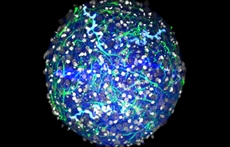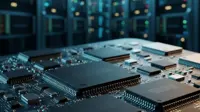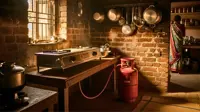Scientists create mini-brains to test new drugs
13 Feb 2016
Researchers at the Johns Hopkins Bloomberg School of Public Health are growing tiny replicas of the human brain to help the study of neurological diseases in a trend many hope could lead to better treatments and even cures for some of the most debilitating illnesses.
 The Hopkins scientists join a handful of other medical researchers around the country who are culturing so-called "mini-brains" in the lab. It's a relatively new field of scientific inquiry that could revolutionize how new drugs are tested for effectiveness by replacing drug testing on lab animals with testing on human cells. This process could offer more accurate test results and help in the development of new, more effective drugs.
The Hopkins scientists join a handful of other medical researchers around the country who are culturing so-called "mini-brains" in the lab. It's a relatively new field of scientific inquiry that could revolutionize how new drugs are tested for effectiveness by replacing drug testing on lab animals with testing on human cells. This process could offer more accurate test results and help in the development of new, more effective drugs.
The scientists reprogrammed the genes of human skin cells to make them like embryonic stem cells, which have the capacity to develop into any kind of tissue. These stem cells were then nurtured to become brain cells. The researchers presented their work on Friday at the American Association for the Advancement of Science conference in Washington, DC.
When fully grown, the three-dimensional mini-brains measure about 350 micrometres, just visible to the human eye, and look like tiny balls. It takes about eight weeks to grow the brain cells into one of these balls. While the versions aren't exact replicas of brains, they are made of the same neurons and cells found in human brains, feature the same structures and act in the same way.
The mini-brains provide a better testing ground for scientists, said lead researcher Dr Thomas Hartung, who holds the Bloomberg School's Doerenkamp-Zbinden endowed chair in evidence-based toxicology.
Human brains are much more complex than the brains of rats now more typically used in research. And about 95 per cent of the drugs that look promising when tested in animal models fail when tested in humans, said Hartung, who is also director of the school's Center for Alternatives to Animal Testing.
 "A lot of drug development has failed because the animal models don't represent humans," he said. "There is a very big desire to get models that are more human."
"A lot of drug development has failed because the animal models don't represent humans," he said. "There is a very big desire to get models that are more human."
The use of mini-brains in research is a growing field that first emerged when scientists at the Austrian Academy of Science Institute of Molecular Biotechnology in Vienna announced in 2013 that they had grown a small brain that was at the same developmental level as a 9-week-old foetus. The pea-size brain was incapable of functions such as thinking and consciousness.
The mini-brains have become more complex over the years - functioning more and more like an actual brain. Researchers at Stanford University have developed mini-brains with the circuitry that models how cells talk with one another in the brain. Early mini-brains mimicked the brain's architecture, but not as much of the functioning.
"There's been amazing progress in this field over the last few years," said Dr Thomas R Insel, director of the National Institute of Mental Health at the National Institutes of Health, in a release last spring about the Stanford study. The federal agency provided grant money for the study.
"While the technology is still maturing, there is great potential for using these assays to more accurately develop [and] test safety and effectiveness of new treatments before they are used in individuals with mental illness," Insel said in the release.
The mini-brains being developed at Hopkins also contain circuitry that functions like an actual brain, Hartung said. The researchers were able to create large batches of identical mini-brains, which will enable more accurate testing of drugs. The more similar the cells, the better the comparisons that can be made when testing different drugs, he said.
"We can literally produce thousands of these brains in one batch," Hartung said. "This is the big advantage that can allow you to test many substances and combinations of drugs."
Scientists say research on mini-brains could improve the understanding of disorders such as Parkinson's, Alzheimer's and dementia.
Researchers at the University of California, San Diego School of Medicine and Rady Children's Hospital in San Diego are using mini-brains to study Cockayne syndrome, a rare neurodegenerative disease that causes short stature and the appearance of premature aging. Those with the disease also have problems with their nervous system and eyesight. There is no cure for the disease, and people afflicted with it usually die in their 20s.
At the Yale School of Medicine, researchers are using mini-brains to better understand autism, including any genetic links related to it. The team simulated early cerebral cortex development using stem cells from skin biopsies of four patients with the disease. They grew the stem cells into three-dimensional mini-brains and then compared gene expression and developing cell types to family members who don't have autism. The study specifically looked at patients with enlarged heads - a common trait in people with severe autism - to narrow down the research.
They discovered the patients' brain cells grew at a faster pace and that they had much higher levels of a gene called FOXG1, which is key to the brain's early development.
"Mini-brains are helping to speed along research," said Jessica Mariani, who worked on the study as an associate research scientist at The Child Study Center at Yale Medical School.
But she and other scientists say the research can be improved. The mini-brains start to die after a while because they lack blood vessels, so they can't be fed nutrients. They also take longer to grow than animal models and can only be developed to the embryonic stage, Mariani said
"We need to work toward improving the viability of these cells to have better maturation of these mini-brains," Mariani said.
Hartung is applying for a patent for his process for growing the identical mini-brains in large batches and is launching a company called Organome to produce them. He hopes to begin production later this year for use in labs across the country.
"We believe we need to make the mechanism available so that every researcher that needs it can have it tomorrow," he said.



















